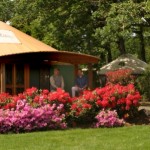
OUR FIRST GUEST BLOG!
When I was working on my book (YURTS:Living in the Round), I found Pete Dolan to be one of the most consistently knowledgeable—and helpful—people in the industry. Pete’s work in Customer Service at Pacific Yurts is one of the reasons their company maintains a legendary reputation for customer satisfaction.
I asked Pete to add his perspective as a guest blogger on the theme of “Buying a Yurt”. Here are his thoughts on
How to Work with a Yurt Company
First, check out company claims
I know these days everybody wants to do all of their research and comparisons online, but keep in mind how easy it is to put together a web site with today’s computers. Someone can put together a web site and make lots of claims without being able to backup or fulfill most of those claims.
It’s important to investigate companies to make sure they are reputable. One way you can do this is by checking with their local Better Business Bureau (www.bbb.org) to see if they have a satisfactory rating. It is worth checking to see if the company has changed their name, too, since this seems to be fairly common and there can be poor ratings for the company under previous names.
Also check web blogs to see if you can find people who have purchased from the companies you are considering in order to find out how satisfied they have been with the quality and service. Checking the company’s rating with Dunn & Bradstreet (www.dnb.com) can also give you a good indication if the company is likely to be around to help you in the future.
If someone’s price seems too good to be true, it probably is. Check the specifications. I’ve seen a number of companies make claims about their products being equal to or better than ours, but their prices were significantly lower. A closer check revealed that inexpensive hardware and fabrics were utilized and the wood frame included far fewer components. For example, one company had up to 32% fewer rafters and lattice in their yurt than our yurt of the same diameter. This can equate to significantly less strength as well.
Solicit advice
If you are getting serious about buying a yurt, contact companies with any questions or concerns you have. I hear about people having problems that could have been avoided if they simply had called someone who is knowledgeable.
For instance, I came across someone on a blog or forum that was having problems with condensation in their yurt. I contacted them to discuss the problem and it turns out that they were using an unvented propane heater in a wet climate, had an interior bathroom with no exhaust vent and never opened their dome skylight when it wasn’t hot outside. They didn’t realize that a by-product of burning propane is water vapor. If you don’t vent the exhaust to the outside you are adding a lot of water vapor into the living space. Since their bathroom didn’t have an exhaust installed more water vapor was being introduced every time they took a shower. With all of this water vapor being brought into the structure and none being vented back outside I could understand why they had condensation. I explained that the more water vapor you bring into the structure, the more you will need to vent back outside in order to avoid water condensing on the interior. They switched to a vented stove and started opening the dome occasionally to allow warm moist air to escape and the condensation problem went away.
Ask about options
Also, don’t assume that a company doesn’t make a particular yurt option and exclude them from your purchasing decision because they don’t show a particular item on their web site. Sometimes we don’t put things on our web site that are likely to confuse prospective customers, or options that are specialty items that are not appropriate for most people.
I’ve spoken with many people who had purchased from another company because they didn’t think we offered something they saw on another web site, only to have problems with the company and/or product later on. (They end up seeking advice from us because of our expertise and trusted reputation.) In some cases they find that we do offer a similar item but don’t promote it on our web site—or they find out specific reasons why we don’t offer such items.
Sometimes folks will call us to ask if we offer an item they saw on someone else’s web site only to find out that we have very specific reasons why we don’t offer that item, which can make a big difference in their long term satisfaction with the product. People tend to be sold on a feature rather than the potential benefits of that feature. Many times features sound good, but can realistically have very limited benefits and lots of disadvantages.
Discuss your individual needs
Our web site is designed so people can educate themselves about the product and our company, but we always prefer to discuss each customer’s individual needs and wants when they are getting close to a purchasing decision so we can make recommendations on which options would be most appropriate for them. This is one reason our pricing is set up to be “ala carte” (http://www.yurts.com/products/default.aspx) rather than pre-packaged yurts where people choose a package that may or may not fit their needs.
Every person’s site, climate, use and individual needs and preferences will differ. Features that one person thinks are essential and should be standard may not be needed or wanted by someone else. A good example is wall height. Many people like having taller walls, but we also have a lot of customers who feel that a lower wall is preferable because of the intimate feeling inside and less space to be heated.
Use our expertise
I often see questions asked on blogs or forums that hang out there unanswered or inaccurately answered that could be quickly and easily answered if the person would have simply contacted us or checked the FAQ section of our web site (e.g., www.yurts.com/what/faq.aspx). Twitter and Facebook offer additional venues for people to ask manufacturers specific questions or post their favorite yurt photos.
Submitted by Pete Dolan
You’ll find Pacific Yurts online at: www.yurts.com, http://www.facebook.com/pacificyurts, & http://twitter.com/pacificyurts
7 Responses to “Buy a yurt 2: How to work with a yurt company”
Sorry, the comment form is closed at this time.

This is a great guest blog – fantastic and important information for yurt lovers. Thanks for this article.
Great insights. As someone who has been burned by a company that was unprofessional in their dealings with us, I staunchly advocate for prospective buyers to read the BBB reviews. Those complaints are not blowing smoke. They capture real-life tragedies by good people who spent hard earned money, only to be burned by unprofessional companies. Thanks for helping protect future buyers!
I have been trying to purchase a yurt for some time now, but they are so darn expensive. I want it to have children a place to do art work for an after school program on a Pueblo reservation. Do you know where I can get one that might be second hand or less cheaper?I teach elementary school children P.E. and then work in an after school program at a Day School. Any information you have is good. Thank you.
I have just read ‘Yurts living in the round’ and found it very useful, it has answered many questions. We are interested in running a Yurt camp in the UK. We are currently looking for land as well as looking at options to purchase. It seems that modem fabric Yurt manufacturers seem exclusive to the USA. From what I have read a fabric Yurt with modern insulation seems perfect for our climate, it however seems strange that most of the European manufacturers are traditional, felt linings etc. From an Eco sense it seems wrong to be shipping heavy crates across the seas to fulfil our requirements or do we simply not need these types of Yurts over here? Thanks Neil
Hi Neil,
Yurtmakers in the UK and EU have appreciated and honored the traditional yurt form and on the whole haven’t been open to the more modern “transformation” of the yurt that occured in North America. On the whole the traditional yurt seems to fit European sensibilities and fondness for tradition better that modern versions.
However, there is at least one company importing the fabric yurts into the EU (you’ll find them listed under “Yurt Companies” on http://www.yurtinfo.org). I agree with you that there is room for the modern yurt in the European market–hopefully someone will take this on at some point, or perhaps some of the traditional yurt builders will begin to upgrade and modernize (as well as selling their beautiful trad. yurts).
thanks for the comment, Neil. I may forward it to a UK yurtmaker to see if he knows of any modern yurt co’s.
Good luck with your yurt dreams,
becky
http://www.yurtinfo.org
Yurtlady on Facebook
I am at the point of purchase…what is the best way to finace yurt and land together. people loook at you like your nuts wanting to live in a yurt.
Hi Elaine,
Yurts can be a challenge to finance. Usually people buy “raw land” using a bank or mortgage co. loan and then finance the yurt seperately using a “Line of Credit” through their bank, or a credit card.
Check out the http://www.yurtinfo.org Classifieds section for used yurts, also Craig’s List.
Pacific Yurts, Colorado Yurt Company and Blue Ridge Yurts may be able to suggest some financing options.
Good luck with getting your yurt and land,
becky